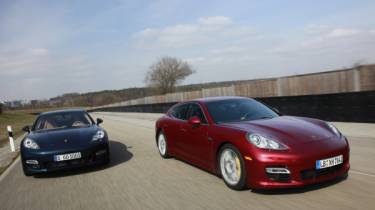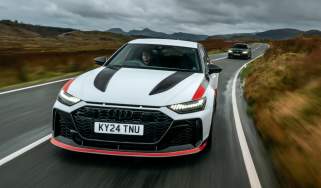Porsche Panamera in motion
evo samples the Panamera at Porsche's Weissach R&D test track
Maybe it does look like a squashed Cayenne. But even the new Panamera, Porsche's long-promised four-door saloon-that's-actually-a-hatchback, doesn't stretch credibility quite the way the SUV did. Porsche can laugh off the purists' Cayenne aversion anyway, for it has openly admitted the lofty beast is the company's cash cow. Will the Panamera enjoy similar success? Now is not the financial climate in which to make such judgments, but if what the Panamera does and the way it does it have anything to do with the outcome, then Porsche can be smug once again. The Panamera is a revelation, nothing less. At least it seems that way from any of the three passenger seats, because we won't be driving it until June. However, several laps of Porsche's very three-dimensional, dipping-and-diving test track at its Weissach R&D centre offered a good opening shot. evo has sampled two Panamerae, the upper versions of the initially three-model range. All three have 4.8-litre V8 engines derived from those used in the Cayenne but lightened with many magnesium components instead of aluminium ones. Power is 400bhp for the atmospheric version, 500bhp for the Turbo which also has the possibility of overboost for a few seconds, increasing power and torque by around 10 per cent. Peak steady-state torque for the Turbo is 516lb ft. The entry-level Panamera (£72,266 when it goes on UK sale in September) has rear-wheel drive. The cars we tried were both four-wheel drive, the 4S (£77,269) and the Turbo (£95,298). Most of the torque goes to the rear wheels most of the time but it's possible, briefly, for all of it to flow to the front if the rear wheels find themselves gripless. A shaft runs from the centre differential forwards and slightly downwards to the front differential via a 'beveloid' gear; the front diff is built into the engine's crankcase and the left-hand front driveshaft passes within a whisker of a crankshaft counterweight. You can have a six-speed manual but Porsche expects most Panameras to contain seven-speed PDK gearboxes as fitted to our two test cars. The full gamut of dual-rate air suspension, active damping, active anti-roll bars and Porsche's usual Stability Management and Sport Plus settings is available in the Panamera, as you would expect. So, lap one in the 4S, belted into the front passenger seat. I'm hemmed in by a high centre tunnel with rows of switches along each edge, giving direct access to functions you'd have to dig for in a BMW iDrive. More such switches appear in a roof console. It's like a flight deck.
Find used Porsche Panamera's for sale on the Classic and Performance Car site here. The engine fires up with an exhalation of energy, but there's no fancy sound-valving in the exhaust system because Porsche says an engine should simply sound like what it is. We start off in Comfort mode, with first gear slurring into to second in luxury-car fashion. First gear is very short-legged, but both it and second can be engaged simultaneously in a double-clutch transmission such as this one, and at traffic speeds the clutches can slip and actually let two gears briefly carry drive at the same time. This smooths the transition between them and makes the Panamera seem less 'busy'. The ride, with both chambers of each air springs operating, is smooth and pillowy but accurately controlled. The notion of a Porsche as a device of waftability is an odd one, but the Panamera performs the role very well. Now lap two, all the toys firmed up in Sport Plus. The air springs now have just one air chamber operating, reducing the air volume and so stiffening the springing effect. If you can alter the spring rate you can tailor your active damping changes much more accurately, and so it proves as the Panamera takes on an entirely different character. This one doesn't have active anti-roll but, now sitting 28mm lower on its springs, it stays taut and level as our Porsche test driver flings it through the bends as if it were a Cayman. This hefty car, the widest (and lowest) of all comparable luxury saloons (hatchback and folding rear seats notwithstanding), appears to defy all forces of inertia. It's light of its type, at around 1700kg, yet it feels lighter. Many outer panels, the front chassis rails, the front suspension towers and the subframes are of aluminium, but the main structure is of various strengths of steel. Magnesium castings form the front-panel frame and the doors' window frames. So the Panamera flicks into corners, understeer right off the dynamic agenda, and slaloms left-right-left with barely a trace of wasted motion. It's extraordinary. But not as extraordinary as the Turbo. I'm in a back seat for this one, enjoying surprising space and the clear view forward past the slender, tapering backrests of the front seats (how refreshing that rear passengers are allowed to see properly where they are going). It takes maybe 10 yards to feel an altogether fiercer Panamera, one equally able to waft but with ferocious and vocal acceleration when needed (0-62mph in 4.2 seconds against the 4S's already-rapid 5.0). It piles into Weissach's corners at mad speeds, even the adverse-camber one which must have caused old 911s a lot of lift-off trouble, yet the nose always finds grip while the tail simply hunkers down on the edge of power oversteer, but never quite getting there (although it will with all the systems off, the test driver assures me). The gearshifts are definite but still smooth, the carbon-ceramic brakes tireless, the ride still remarkable and uncannily flat with the active anti-roll system. The PDK shifters in the steering wheel now slide fore-and-aft instead of pivoting, by the way. One other thing. All Panameras have a retractable rear spoiler which rises to –3deg at 56mph and rises again to +10deg at 127mph. But the Turbo's is something special: as well as rising, it splits into two and widens. You wouldn't believe the cranks and levers and motors lurking within the tailgate. So that's the Panamera, and once again Porsche has taken an alien genre of car and made it work as a Porsche should. On this first encounter it's an extraordinary machine. Aston Martin's Rapide will have a tough job to trump this.



